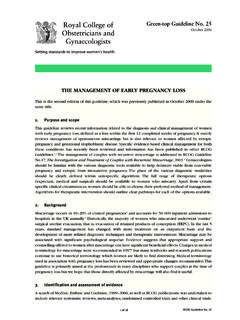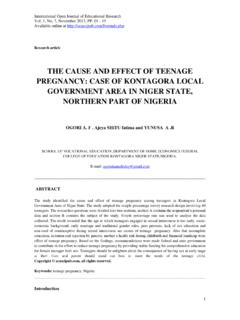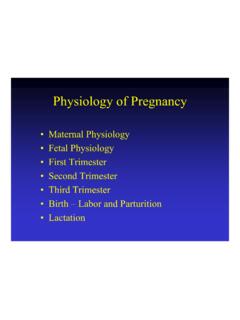Transcription of ULTRASOUND – EARLY PREGNANCY DIAGNOSIS AND FETAL SEXING
1 Proceedings, Applied Reproductive Strategies in Beef Cattle October 27 and 28, 2005, Reno, Nevada ULTRASOUND EARLY PREGNANCY DIAGNOSIS AND FETAL SEXING G. Cliff Lamb and Paul M. Fricke North Central Research and Outreach Center, University of Minnesota, Grand Rapids Department of Dairy Science, University of Wisconsin, Madison Introduction The area that has arguably benefited more from the development of ULTRASOUND technology than any other area is reproduction in large animals. In many cases, rectal palpation has been replaced by transrectal ultrasonography for PREGNANCY determination, and diagnoses associated with uterine and ovarian infections. In addition, ultrasonography has added benefits such as FETAL SEXING , EARLY embryonic detection and is less invasive than rectal palpation.
2 From a research standpoint, ULTRASOUND has given us the ability to visually characterize the uterus, fetus, ovary, corpus luteum, and follicles. More accurate measurements of the reproductive organs has opened doors to new areas of research and validated or refuted data from past reports. Practical application of ULTRASOUND by bovine practitioners for routine reproductive examinations of cattle is the next contribution this technology is positioned to make to the livestock industry. Most veterinary students continue to be taught that ULTRASOUND is a secondary technology for bovine reproductive work; however, the information-gathering capabilities of ultrasonic imaging far exceed those of rectal palpation (Ginther, 1995). This paper will discuss the impact and practical applications of ULTRASOUND for conducting routine reproductive examinations in dairy cattle.
3 Imaging the Bovine Uterus and Conceptus Of all the ULTRASOUND applications utilized by technicians in the industry, scanning of the uterus for infection and PREGNANCY are the most commonly practiced commercial applications that we have seen in the cattle industry. In a nonpregnant, cycling cow the uterine tissue appears as a somewhat echogenic structure on the screen. Because the uterus is comprised of soft tissue it absorbs a portion of the ULTRASOUND waves and reflects a portion of the waves. In this way we can identify the uterus as a gray structure on the screen. A cross-sectional view of the uterus is displayed as a rosette and is easily distinguished from other peripheral tissues, whereas the longitudinal section is less recognizable, yet a trained technician can differentiate between the elongated view of the uterus and other tissues that may appear similar.
4 Physiological changes during the estrous cycle leads to physical changes (such as tone) in the uterus, which alters the echogenic properties of the uterus (Pierson and Ginther, 1987). Even though a scoring system has been developed to describe changes in uterine echogenic ability during different stages of the estrous cycle (Pierson and Ginther, 1987), predicting the stage of the estrous cycle remains inconsistent. Pathological applications for ULTRASOUND technology have extended to identifying endometritis, pyometra, mucometra, and hydrometra (Perry et al., 1990). With the aid of ULTRASOUND , researchers have determined that uterine infections were related to delayed postpartum folliculogenesis (Peter and Bosu, 1988), to the occurrence of short luteal phases after 253the first postpartum ovulation (Peter and Bosu, 1987), and to the development of follicular cysts on the ovaries (Peter and Bosu, 1987).
5 Detection of the embryo proper as well embryonic and FETAL developmental characteristics during EARLY FETAL development are shown in Table 1 and 2. The bovine fetus can be visualized beginning at 20 d post-breeding and continuing throughout gestation, however, because of its size in relation to the image field of view, the fetus cannot be imaged in toto after about 90 days using a MHz linear-array transducer. Table 1. Day of first detection of ultrasonographically identifiable characteristics of the bovine conceptus (Adapted from Curran et al., 1986). First day detected Characteristic Mean Range Embryo proper 19 to 24 Heartbeat 19 to 24 Allantois 22 to 25 Spinal cord 26 to 33 Forelimb buds 28 to 31 Anmion 28 to 33 Eye orbit 29 to 33 Hindlimb buds 30 to 33 Placentomes 33 to 38 Split hooves 42 to 49 FETAL movement 42 to 50 Ribs 51 to 55 Table 2.
6 FETAL crown-rump length in relation to age in weeks (Hughes and Davies, 1989). Crown-rump length, mm FETAL age, weeks No. of observations Minimum Maximum Mean 4 25 6 11 5 35 8 19 6 50 16 26 7 47 23 36 8 41 36 52 9 48 39 71
7 10 43 61 101 11 39 95 118 12 32 107 137 254 EARLY PREGNANCY DIAGNOSIS Reports have indicated the detection of an embryonic vesicle in cattle as EARLY as 9 (Boyd et al., 1988), 10 (Curran et al., 1986), or 12 days (Pierson and Ginther, 1984) of gestation. In these situations the exact date of insemination was known and ultrasonography simply was used as a confirmation of PREGNANCY or to validate that detection of an embryo was possible within the first two weeks of PREGNANCY .
8 In contrast, Kastelic et al. (1989) monitored PREGNANCY in pregnant and nonpregnant yearling heifers that were all inseminated. DIAGNOSIS of PREGNANCY in heifers on day 10 through day 16 of gestation resulted in a positive DIAGNOSIS for pregnant or nonpregnant of less than 50%. On days 18, 20, and 22 of gestation accuracy of PREGNANCY DIAGNOSIS improved to 85%, 100%, and 100%, respectively. Although evidence of a PREGNANCY via ULTRASOUND during days 18 to 22 of gestation yields excellent results, a technician needs to ensure that confusion between fluid accumulation in the chorioallantois during EARLY PREGNANCY (Kastelic et al., 1989) and uterine fluid within the uterus during proestrus and estrus are not confused when making the DIAGNOSIS . Several further reports (Taverne et al., 1985; Hanzen and Delsaux, 1987; Pieterse et al.)
9 , 1990, Badtram et al., 1991) also indicate the presence of an embryonic vesicle as EARLY as day 25 of gestation. Although Hanzen and Delsaux (1987) utilized a MHz transducer for PREGNANCY DIAGNOSIS , they concluded that by day 40 of gestation a positive DIAGNOSIS of PREGNANCY was 100% accurate, whereas overall DIAGNOSIS of PREGNANCY and absence of PREGNANCY from day 25 of gestation proved to be correct in 94% and 90% of cases, respectively. In 148 dairy cows, PREGNANCY DIAGNOSIS from day 21 to day 25 was 65% accurate, whereas DIAGNOSIS of PREGNANCY from day 26 to day 33 was 93% accurate (Pieterse et al., 1990). In their conclusions, the authors state that probable causes of misdiagnosis from day 21 to day 26 were either an accumulation of proestrus or estrus uterine fluid, or the accumulation of pathological fluid in the uterus, or were diagnosed pregnant but experienced EARLY embryonic loss.
10 Although we have indicated that an embryonic vesicle is detectable by ULTRASOUND as EARLY as 9 days of gestation, accuracy of detection approaches 100% after day 25 of gestation. For practical purposes, the efficiency ( , speed and accuracy) of a correct DIAGNOSIS of PREGNANCY should be performed in females expected to have embryos that are at least 26 days of age (Figure 1). This information can be used to determine the age of bovine fetuses with a high degree of accuracy (Pierson and Ginther, 1984; Boyd et al., 1988; Ginther, 1995). Crown-Rump length measurements were summarized by Hughes and Davies (1989; Table 3). There was a significant correlation (r = ) between embryo age and crown-rump length. 255 Figure 1. ULTRASOUND images of the bovine fetus at various stages of development (Lamb, 2001).









